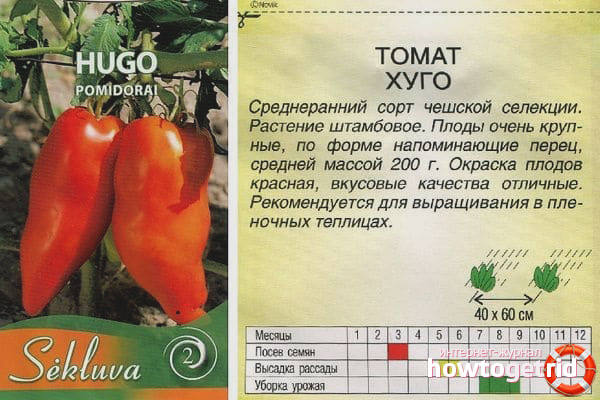The content of the article
Tomatoes of this variety are distinguished by their high resistance to late blight infection, are not susceptible to gray rot, and also to verticillous withering of fruits. Tomatoes were bred by a company called Moravoseed.
general information
Tomatoes are medium late, indeterminate. Before the first crop ripens, about 110 days pass. Plants need to remove excess shoots growing on the sides. Therefore, gardeners recommend installing special supports, or tie the plant to a support. This point is due to the fact that this variety is characterized by the presence of large fruits. About 10 brushes can form on one bush, up to 6 tomatoes ripen on each of them, all of them have an identical shape, color.
Experts say that Hugo has excellent yield - you can get about 12 kg of fruit per 1 m².
What are the main characteristics of the variety can be distinguished?
- color is red;
- the shape is cylindrical;
- the peel is dense.
Tomatoes usually have 3-4 chambers, and the standard weight reaches 200 grams. Perfect for both preservation and fresh consumption.
They can be transported without fear that the fruits will be damaged. Stored up to six months in a cool, dry place. Among gardeners, this variety is popular due to the fact that plants are resistant to most diseases, they are easy to store, and the bushes give an excellent harvest, up to September. It can be grown in greenhouse conditions and in the garden.
How to grow?
To get an early harvest, seedlings need to be planted in February. Due to the fact that the seeds are already being treated with special antifungal substances, additional dressing with potassium permanganate is not required. Nevertheless, many gardeners soak seeds in aloe juice - they need to be kept for 10-12 hours.
It is very important to choose the right soil if you want to get healthy, strong seedlings. The best option: to purchase a mixture for the soil in a specialized store, but if it is not possible, then the soil is prepared independently. To do this, you will need 1 bucket of pre-sifted humus, add ashes flour in the amount of 1 kg, sand, peat - 1 kg each. The soil needs to be warmed up, it should be in a warm room for about 4-5 days.
The first sunrises can be seen after 3-4 days. Dilute a weak solution of potassium permanganate, spray them using a spray gun. Watering should be done regularly, as the soil dries. Watering and lighting are important components of plant care. The optimum air humidity is 65%, the ambient temperature is + 22C, and the plant needs 18 hours of light per day.
As soon as the first leaves are visible, it is advisable to sprinkle the seedlings using the soil mixture (we cook ourselves, or we get ready-made). After 2-4 sheets appear, with a distance of 10x10, a pick is done. It is necessary that the root system and stem are strong and well developed.
When the plant reaches 25-30 cm, you can start planting on the bed, but the soil must be cultivated beforehand: gardeners recommend using Bordeaux liquid for this purpose. So called a special chemical substance that prevents the occurrence of infections and various diseases.
Reviews
- Marina V., 45 years old: I have been growing vegetables for quite some time, but Hugo found out about the tomato variety only last year. I immediately wanted to try tomatoes - all the more, as they say, their fruits can reach 250 grams - rather large, ideal for making light and healthy snacks. There were no problems with seedlings, the variety is resistant to diseases. Watering regularly. Did a pick. As a result, without much concern, I managed to please my loved ones with delicious tomatoes right from the garden!
- Valentina Ivanovna, 36 years old: The variety is fruitful, unpretentious in care. The only thing that is important to do on time is a pick, due to the fact that this variety is characterized by large and rather heavy fruits. Plants do not get sick, are not susceptible to phytophlora, and require minimal care. If you properly prepare seedlings - will eat delicious tomatoes until the end of September.
Video: Determinant Tomatoes - Formation and Care











Submit